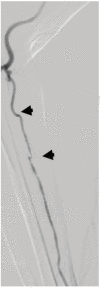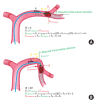Unfavorable Vascular Anatomy during Endovascular Treatment of Stroke: Challenges and Bailout Strategies
- PMID: 32635684
- PMCID: PMC7341011
- DOI: 10.5853/jos.2020.00227
Unfavorable Vascular Anatomy during Endovascular Treatment of Stroke: Challenges and Bailout Strategies
Abstract
The benefit of mechanical thrombectomy (MT) in acute ischemic stroke (AIS) due to large vessel intracranial occlusions is directly related to the technical success of the procedures in achieving fast and complete reperfusion. While a precise definition of refractoriness is lacking in the literature, it may be considered when there is reperfusion failure, long procedural times, or high number of passes with the MT devices. Detailed knowledge about the causes for refractory MT in AIS is limited; however, it is most likely a multifaceted problem including factors related to the vascular anatomy and the underlying nature of the occlusive lesion amongst other factors. We aim to review the impact of several key unfavorable anatomical factors that may be encountered during endovascular AIS treatment and discuss potential bail-out strategies to these challenging situations.
Keywords: Brain ischemia; Reperfusion; Stroke; Thrombectomy.
Figures













References
-
- Berkhemer OA, Fransen PS, Beumer D, van den Berg LA, Lingsma HF, Yoo AJ, et al. A randomized trial of intraarterial treatment for acute ischemic stroke. N Engl J Med. 2015;372:11–20. - PubMed
-
- Bracard S, Ducrocq X, Mas JL, Soudant M, Oppenheim C, Moulin T, et al. Mechanical thrombectomy after intravenous alteplase versus alteplase alone after stroke (THRACE): a randomised controlled trial. Lancet Neurol. 2016;15:1138–1147. - PubMed
-
- Campbell BC, Mitchell PJ, Kleinig TJ, Dewey HM, Churilov L, Yassi N, et al. Endovascular therapy for ischemic stroke with perfusion-imaging selection. N Engl J Med. 2015;372:1009–1018. - PubMed
-
- Goyal M, Demchuk AM, Menon BK, Eesa M, Rempel JL, Thornton J, et al. Randomized assessment of rapid endovascular treatment of ischemic stroke. N Engl J Med. 2015;372:1019–1030. - PubMed
Publication types
LinkOut - more resources
Full Text Sources
Other Literature Sources

